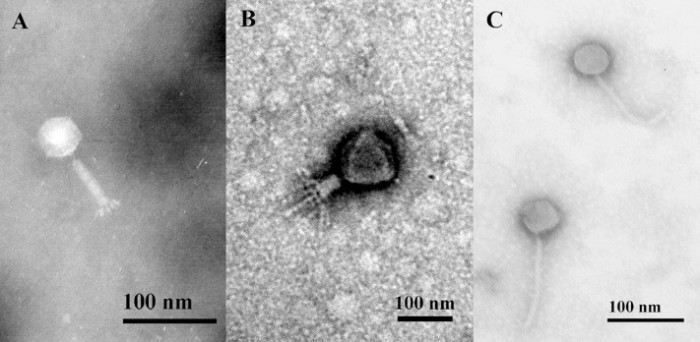When most people think about viruses they think of nasty diseases like the flu, HIV, or polio but believe it or not some viruses may be used to prevent diseases! They are called bacteriophages and instead of attacking humans, they parasitize pathogenic bacteria.
Bacteriophages are viruses that are capable of infecting bacteria. There is a wide variety of phages some are simple and others have complex anatomies. Two structural features that all phages have in common are genetic information in the form of either DNA or RNA, and a nucleocapsid comprised of proteins that encases the genetic material. Viruses cannot reproduce independently; they rely on cellular mechanisms to reproduce. They parasitize the host bacteria and use the cells transcriptional and translational machinery to produce bacteriophage proteins and genetic material. Once they have produced and assembled the viral components into new virulent phages they use lysozymes an enzyme to break down the structure of the cell and release the next generation of phages (Phages, 2013).
Bacteriophages were discovered in 1916 and were first used treat bacterial infections in the 1920s. Although they were promising, there were some difficulties in experimentation with the phages and after natural and synthetic antibiotic molecules became widely available phages fell off the map in western medicine. However in eastern medicine they remained popular and people have been using them up to this day. With the rapid emergence of antibiotic resistant strains of bacteria, which are difficult to eliminate with traditional drugs, it may be time to look into using bacteriophages once again to combat bacterial infections (Chanishvili, 2012)
Phages are not only a potential treatment for human infections but also for other animals. In Asia sea cucumbers are widely used for food but different types of bacteria including Vibrio splendidus can infect them fatally. In a recent experiment three varieties of bacteriophages were isolated and used as therapeutic treatments on bacteria infected with V splendidus. This graph sums up the findings of the experiment pretty well. The negative control is sea cucumbers infected with the bacteria but not treated. Just 18% survived the 10 day observation period. The group treated with the antibiotic drug doxycyclin had a survival rate of 82%. Each of the three groups treated with a different strain of the bacteriophage had survival rates much better than the negative control group but significantly lower than the antibiotics. The three phages when combined together in a cocktail exhibited a survival rate that was the same as the anti biotic treatment!
These findings are interesting and significant because it is important for the sea cucumber industry. Affective alternatives to antibiotics are in high demand and the more antibiotics we treat our food with, the more resistant strains of bacteria will crop up in our food and possibly in us. Also it is important because it is an in vivo experiment (in live animals), which can start paving the path for more clinical trials with human subjects. Who knows, a in a few years you Dr. may write you a prescription for a bacteriophage cocktail. 


Chanishvili N. Phage therapy-history from Twort and d’Herelle through Soviet experience to current approaches Adv. Virus Res., 83 (2012), pp. 3–40
Phages.org (2013). Phage Therapy. http://phages.org (Accessed April, 2016)
Zhen Li, Xiaoyu Li, Jiancheng Zhang, Xitao Wang, Lili Wang, Zhenhui Cao, Yongping Xu, Use of phages to control Vibrio splendidus infection in the juvenile sea cucumber Apostichopus japonicus, Fish & Shellfish Immunology, Volume 54, July 2016, Pages 302-311, ISSN 1050-4648